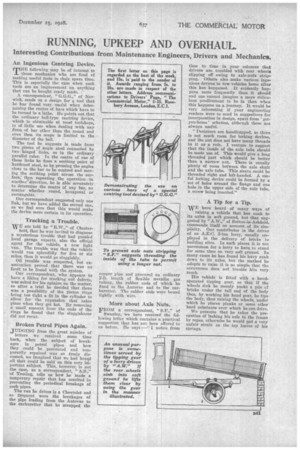RUNNING, UPKEEP AND OVERHAUL.
Page 29

If you've noticed an error in this article please click here to report it so we can fix it.
Interesting Contributions from Maintenance Engineers, Drivers and Mechanics.
An Ingenious Centring Device.
THE following may be of interest to those mechanics who are fond of making useful tools in their spare time. 'Phis is especially the ease when such tools are an improvement on anything that can be bought ready made.
A correspondent, " G.G.G.," of Norwich, sends in a design for a tool that be has found very useful when determining the centre of bars which have to be turned in a lathe. He points out that the ordinary bell-type centring device, which is obtainable at most toolshops, is of little use when dealing with any form of bar other than the round and even then its scope is limited to the diameter of the bell.
The tool he suggests is made from two pieces of angle steel connected by two hinged links, as in the ordinary Parallel ruler. In the centre of one of these links he fixes a scribing point of hardened steel, so by pressing the angles close to the bar to be centred and moving the scribing point across the surface, then repeating the operation in another direction, he is able accurately to determine the centre of any bar, no matter whether round, hexagonal or rectangular.
Our correspondent suggested only one link, but we have added the second one, as we feel sure that this would make the device more certain in its operation.
Tracking a Trouble.
WE are told by " R.W.," of Chester
field, that he was invited to diagnose a mysterious trouble that had puzzled local garage experts, also the official agent for the vehicle, a new light van. The trouble was that the vehicle would run splendidly for five or six miles, then it would go sluggishly.
Oil trouble was suspected, but examination proved that there was no fault to be found with the system. Our correspondent, who appears to have a liking for tracking out defects, was asked for his opinion on the matter, so after a trial he decided that there was a possibility of the Piston rings being too tight a fit in the cylinder to allow for the expansion that takes place when they get hot. By removing a small amount from the ends of the rings he found that the sluggishness did not recur.
Broken Petrol Pipes Again.
JUDGING from the great number of
letters we received some time back, when the subject of breakages in petrol pipes and how they could be prevented and temporarily repaired was so freely discussed, we imagined that we had beard all that could be said on this very important subject. This, however, is not the case, as a correspondent, " AS.," of Tooting, tells us how he made a temporary repair that has resulted in preventing the periodical breakage of such pipes.
The van he drives is a Chevrolet and so frequent were the breakages of the pipe leading from the Autovac to the carburetter that he scrapped the copper pipe and procured an ordinary 2-ft. length of flexible metallic gas tubing, the 'rubber cads of which he fixed to the Autovac and to the carburetter. The rubber ends were bound tightly with wire.
More about Axle Nuts. .
FRO:NI a correspondent, " S.F.," of Ssvanley, we have received the following letter which contains a practical suggestion that has not been offered to us before. He says :—" I notice from
time to time in your columns that drivers are troubled with rear wheels slipping off owing to axle-nuts stripping. Others also make various ingenious devices to tow vehicles home after this has happened. It evidently happens more frequently than it should and one cannot imagine a more ridiculous predicament to be in than when this happens on a journey. It would be very interesting if your engineering readers were to send in suggestions for incorporation in design, apart from 'getyou-home' schemes, although these are always useful.
"Designers are handicapped, as there is not much room for locking devices, and the nut does not have many threads in it as a rule. I venture to suggest that the inside of the axle tube should be made use of. This would give a long threaded part which should be better than a narrow nut. There is usually plenty of room between the axle shaft and the axle tube. This sleeve could be threaded right and left-handed. A useful locking device could be formed by a set of holes around the flange and one hole in the upper side of the axle tube, a screw being inserted."
A Tip for a Tip.
WE have heard of many ways of
raising a vehicle that has sunk to its axles in soft ground, but that suggested by " A.W.," of Sutton-in-Ashfield. commends itself on account of its simplicity. Our contributor is the driver of an A.E.C. 5-ton lorry, usually employed in the delivery of bricks 10 building sites. In such places it is not uncommon for a lorry to have to stand for some time on very soft ground. In many cases he has found his lorry sunk down to its axles, but the method be adopts to raise it is so simple that the occurrence does not trouble him very much.
The vehicle is fitted with a handoperated tipping gear, so that if the wheels sink he merely packs a pile cf bricks under the tail end of the body then, by working his hand gear, he tips the body, thus raising the wheels, under which he places planks or some other hard substance over which he can drive.
We presume that he takes the precaution of lashing his axle to the frame by ropes, otherwise be would put a very unfair strain on the top leaves of his springs.






























